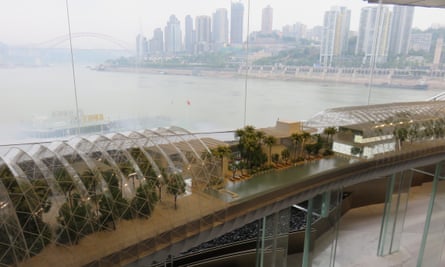An army of 6,000 construction workers is hard at work at a large site overlooking the conflux of the Yangtze and Jialing rivers in the south-western Chinese megacity of Chongqing. Eight skyscrapers are rising from the river banks: two above 350m and six above 250m.
Raffles City Chongqing, a project headed by the architect Moshe Safdie, will boast 134,000 sq m of homes, shops, offices, entertainment, transportation links and a public park. It also features a more unusual claim to fame: a “horizontal skyscraper” 300m in length, stretching across four of the main towers at the 42nd floor. With the building situated in an earthquake zone, it “floats” on top of the towers to accommodate the necessary sway.
No landmark development in China is complete without a world record, and Raffles City Chongqing has the highest skybridge linking the most towers. With an adjacent pair of towers connected by smaller skybridges, workers and residents can move around the eight-tower development without needing to return to ground level.
“It’s going to become like the heartbeat of the city,” says Safdie of what he describes as his most complex project to date. “In these dense cities like Chongqing there’s no room for big public parks [on the ground], so we have to lift them into the sky.”
Chongqing is certainly dense. Outside the building site, the streets are crowded with markets and wholesalers, hawkers and food stalls. Construction workers huddle over bowls of spicy noodles, vendors carry heaving baskets of fruit on their shoulders and shoppers barter over prices.
Safdie says the development reflects a growing trend in urban planning: having developed vertically, skyscraper cities are starting to spread horizontally.
“I see a period in which zoning changes to being more three-dimensional,” he says. “Rather than just thinking of land as two-dimensional, zoning will start requiring people to connect between one property and another – first at ground level, then above ground.”

The skybridge is going to house a public observatory, a residents’ clubhouse, hotel lobby and several restaurants, plus an outdoor viewing deck. Safdie and his team have already trialled connecting bridges between towers at their schemes Sky Habitat and Marina Bay Sands in Singapore.
There have been other seeds of experimentation. Minneapolis is home to the world’s most extensive skyway system – and in Asian cities such as Hong Kong and Bangkok skywalks are publicly run facilities, connecting buildings, stations and walkways. These often run only a few floors above the ground – but as towers become taller, skywalks are ascending with them.
Beijing’s Linked Hybrid complex is a series of towers connected by a series of skybridges between the 12th and 18th floors. Singapore’s Pinnacle@Duxton is a large public housing project with seven 51-storey apartment blocks connected by skybridges and skyparks, and the Velo Tower in Seoul has two skyscrapers joined by a 30-storey-high skybridge.

“The idea of requiring connectivity could be extended – you could even zone off a public street at the 25th level, and anything that reaches 25 floors up would have to accommodate that,” adds Safdie. “You’d have all these opportunities to do things beyond a single parcel of land, and I think that’s where we’re going.”
If sky-high connections between buildings are the future, then technology will hasten its arrival. Last year, the German engineering firm ThyssenKrupp unveiled its new horizontal-vertical elevator system. The Multi allows multiple lifts in one shaft, removes height limitations and allows for horizontal lifts to shuttle from one building to another. Buildings could reach higher, and reach across, creating an interconnected network that stretches across the city.
“It gives us choices of how to understand the building in a different way,” says Michael Cesarz, CEO of Multi at ThyssenKrupp. “For me, being an architect and an engineer, I don’t have to think of lifts as the centre of the building anymore – I can put them anywhere I like. Moving horizontally creates some new sorts of freedoms. You can move people from one end to the other end of the same or connected buildings. You don’t even have to step out of the lift.”
But what are the social implications of a life lived in the air? Could this trend for linked skyscrapers accelerate segregation, creating a two-tier city socially as well as physically: sky-high cities for the elite with everyone else stuck at ground level?
Matthew Clifford, the head of energy and sustainability services at JLL Asia Pacific, believes connected tall buildings can have a positive impact – avoiding pollution and traffic at ground level, for example.

But he warns: “You need to think very carefully about how people will use the building, and how skybridges could become exclusive, full of luxury restaurants and high-end amenities. The risk is that you can design this architectural feat that ends up only being relevant for a small number of people.”
At Raffles City Chongqing, most of the skybridge amenities will be open to the public. The project includes a public park surrounding the towers, while the metro and a bus station connect directly.
Safdie argues that the publicly accessible skybridge goes against conceptions about exclusivity. “The tendency is to have a couple of floors for the people, near the ground, and then reserve the upper floors for luxury use,” he explains. “We can’t totally overcome that, because it’s so much part of the culture and the market to make the top luxury.
“But in Chongqing we bring people in on different levels: through the park, through the subway, from the bus station, from the parking lot underneath. And to really democratise the building [we have placed] something that’s truly public right at the top, in a way that draws people right through the project.”
Follow Guardian Cities on Twitter, Facebook and Instagram to join the discussion, and explore our archive here

Comments (…)
Sign in or create your Guardian account to join the discussion